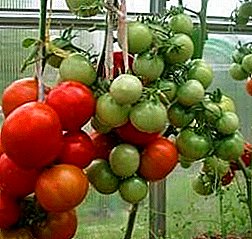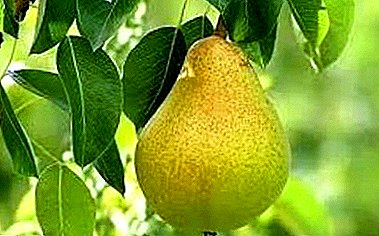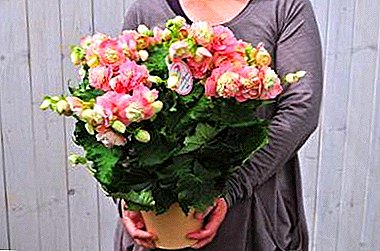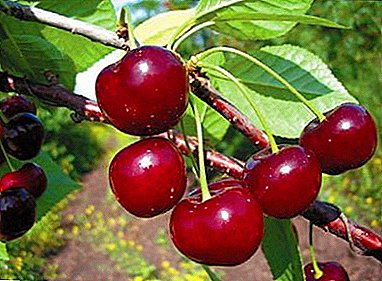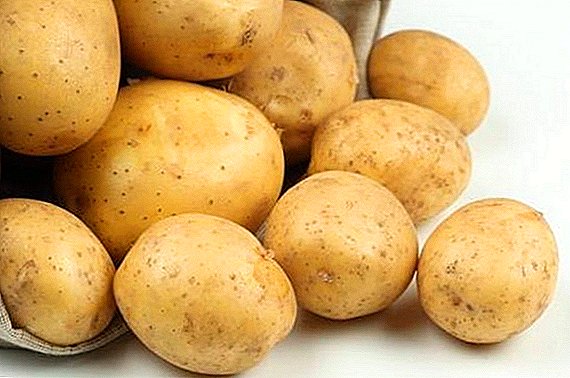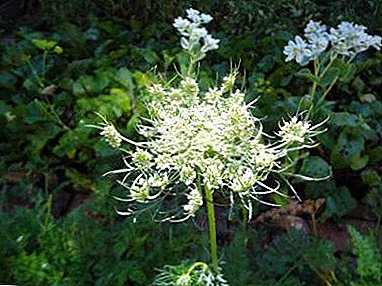
Carrots are pleasant to the taste and healthy root vegetable that grows in almost every garden plot. It is very often used to prepare all sorts of dishes, and therefore it is grown almost everywhere.
But there is a common problem among gardeners - this is the flowering of vegetables in the first year of growth. This is due to agrotechnical violations and the influence of various factors.
The growth of arrows leads to irreversible processes that reduce the quantity and quality of the crop. Let us tell why the flowers appear in carrots and show in the photo how they look.
Botanical description
- Inflorescence formula: Ч5- ОЛ5Т5П2.
- The flowers are bisexual, white, small, up to 2-3 mm, consist of five twin petals, resembling a constricted heart, are located on a small receptacle.
- Pistil and stamens are light green, stamens short, thickened.
- Sepals are small, do not protrude beyond the petals.
- Flowers are formed in inflorescences of 12-15 pieces.
Appearance of inflorescences, photo
Externally, the root flower looks like an umbrella with 15-20 rays. The rays of the umbrella are rough-pubescent, revealed during flowering, with fruits compressed together. The flower is white, rather large in size (12-15 cm), consists of 50 inflorescences.
If you take a closer look at it, you can see a lot of small white flowers with inconspicuous teeth, cups with white, yellowish or pink petals.
A dark red flower is visible in the center of the umbrella.. The first bloom central inflorescence, then gradually dissolve the rest.





Why is this a problem for the gardener?
Carrots are a biennial vegetable. In the first year brings fruit that can be eaten. In the second, the stems with buds grow from the roots. But it happens that when sowing in the winter in the first year instead of the root grows spike. In this case, the plant becomes unusable.
Flowering carrots saddened vegetable growers who expect to get a generous harvest. BUT when brooded, there is an abundant growth of seeds, leading to a root crop depleting. It does not form and does not develop, it becomes coarse, dry and unsuitable for food. All forces, nutrients are spent on forcing the arrow, and not on the development of the root.
When does it happen?
The causes of flowering are associated with both climate change and violations of agronomic technologies:
- Short daylight hours - less than 10 hours a day. At night, the plants undergo complex biochemical reactions that lead to the formation of peduncles.
- The cold spring contributes to the fact that in the first year, instead of large fruits, flower arrows appear on the garden bed.
- Unheated ground.
- Seeds of poor quality, which arose as a result of the inter-pollination of sowing carrots with wild.
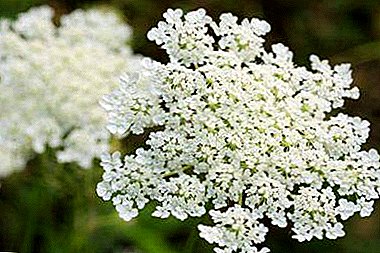 Vernalization is a long-term effect on planting material of low positive temperatures (from 0 to 4 degrees). As a result, there are disturbances in the metabolism in the seeds, causing the transition of the vegetable from vegetative to generative growth. The culture of the vegetable is transformed into decorative. Under such weather conditions, the cold period replaces carrots for the first year of the growing season, and the warm one is mistakenly perceived as the second year, so the plants begin to bloom.
Vernalization is a long-term effect on planting material of low positive temperatures (from 0 to 4 degrees). As a result, there are disturbances in the metabolism in the seeds, causing the transition of the vegetable from vegetative to generative growth. The culture of the vegetable is transformed into decorative. Under such weather conditions, the cold period replaces carrots for the first year of the growing season, and the warm one is mistakenly perceived as the second year, so the plants begin to bloom.- The thickening of the planting seeds and poor thinning.
- Lack or excess moisture in the soil at high temperatures.
- Frost at the time of sowing.
- Excessively fertilized soil.
Having taken into account all the reasons for which the vegetable crop shoots, it is necessary to promptly eliminate unfavorable factors.
How to understand that the root goes to the arrow?
After some time, a folded green umbrella appears at the top. By the time of flowering, the umbrella opens and tiny buds appearwhich then become white flower stalks.
What to do to the carrot is not gone in color - step by step instructions
In order to avoid the appearance of peduncles on the plot, it is necessary to follow some recommendations:
- When buying seeds pick varieties resistant to strelkovuyu. These include such high-yielding species as "Vitamin", "Canning", "Nantes 4", "Incomparable", "Cold-Resistant19".
- Choose a bed for sowing, taking into account the recommendations for crop rotation: the best predecessors for carrots are cabbage, tomatoes, cucumbers, potatoes.
- To carry out the podzimniy sowing in the frozen ground, and spring in the warmed up to +5 degrees. If the air temperature has decreased, the beds should be covered with foil.
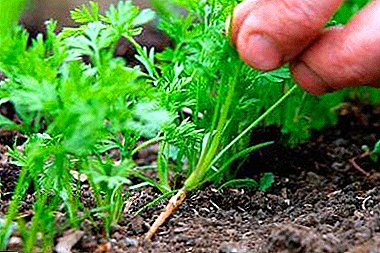 Sow root crops with lighthouses to make it easier to care for row-spacing.
Sow root crops with lighthouses to make it easier to care for row-spacing.- To thin out shoots, then there will be no thickening of crops.
- Water regularly and abundantly, and not every day in small portions.
When planning a landing you need to consider that “Good neighbors” for a healthy root crop will be such cultures as:
- salad;
- radish;
- garlic;
- legumes.
Neighborhood with parsley, horseradish, beets, celery is best avoided.
The soil under the carrot should not be stony and dense. Before sowing should dig it and carefully loosen. The crop yields a good harvest on sandy soils with neutral acidity, saturated with organic and mineral fertilizers, which are applied 2-3 years before sowing.
Excessive fertilizer and frequent feeding leads to the growth of roots and marksman.
For sowing, large intact seeds with a shelf life of not more than 2 years are used.
- First, they are checked for germination.
- Then processed with a weak solution of manganese or soaked in water.
- Also soaked with nutrient mixture (solution of mullein, peat, humus).
- For sowing on a bed, grooves are preliminarily prepared at a width of 30 cm from one another. Seeds are laid to a depth of no more than 2 cm in a well-moistened soil.
- It is recommended to maintain a high level of soil moisture in order to create optimal conditions for seed germination. To do this, the bed after the first watering is usually covered with plastic wrap.
- As soon as the first 3-4 leaflets appear, the first additional feeding is carried out with a solution of ammonium nitrate. Carrying out the second and third dressing, superphosphate solutions are applied.
- A prerequisite for good growth of carrots, and in the future of obtaining a high yield, it is necessary to thin out the crops and regularly loosen the row spacing, preferably after each rain.
- During heavy rains it is recommended to cover the beds to avoid their bay.
- Thinning is performed 3-4 times for the full growing season.
Since carrots are a vegetable with a two-year growth cycle, the appearance of peduncles in the second year after sowing is considered normal. It is the seeds that ripened in the second year that are considered to be of high quality, which can produce large fruits and a good harvest. This must be taken into account when growing carrots for seeds.
In order for a tasty and crisp vegetable to be in the daily diet of the whole family, it is necessary, when preparing for sowing, to take into account all the listed reasons why carrots go in color. Follow all the recommendations and advice to prevent the appearance of white umbrellas on the garden. And then a rich and high-quality harvest will delight its owner.


 Vernalization is a long-term effect on planting material of low positive temperatures (from 0 to 4 degrees). As a result, there are disturbances in the metabolism in the seeds, causing the transition of the vegetable from vegetative to generative growth. The culture of the vegetable is transformed into decorative. Under such weather conditions, the cold period replaces carrots for the first year of the growing season, and the warm one is mistakenly perceived as the second year, so the plants begin to bloom.
Vernalization is a long-term effect on planting material of low positive temperatures (from 0 to 4 degrees). As a result, there are disturbances in the metabolism in the seeds, causing the transition of the vegetable from vegetative to generative growth. The culture of the vegetable is transformed into decorative. Under such weather conditions, the cold period replaces carrots for the first year of the growing season, and the warm one is mistakenly perceived as the second year, so the plants begin to bloom. Sow root crops with lighthouses to make it easier to care for row-spacing.
Sow root crops with lighthouses to make it easier to care for row-spacing.


